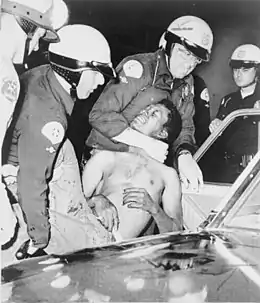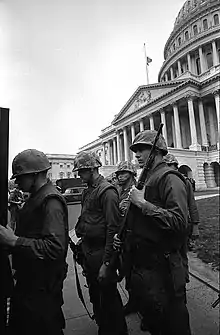Ghetto riots in the United States (1964–1969)
The term ghetto riots, also termed ghetto rebellions, race riots, or negro riots refers to a series of summer uprisings across the United States in the 1960s, characterized by African American groups using violent tactics to secure social justice.[1][2]
| Ghetto riots | |
|---|---|
 Man arrested during the Watts riots | |
| Date | 16 July 1964 - 29 July 1969 |
| Location | |
| Caused by | |
| Methods | Widespread rioting, looting, assault, arson, property damage |
| Casualties | |
| Arrested | 20,000+ |
The six days of unrest throughout New York City during the Harlem riot of 1964 is viewed as the first of clusters of riots, uncoordinated with each other, evidently unplanned, most often in cities during the summer months. The pattern caused 159 separate incidents of violence and unrest over the long, hot summer of 1967, came to a climax during the national wave of King assassination riots in over 100 American cities in 1968, and relented in 1969.
History
Background
Before the ghetto riots of the 1960s African American resistance to white supremacy was much more limited, including only small slave rebellions and armed defenses in the early 1900s. Most of these actions were defensive in nature rather than retaliatory, it was not until the Harlem riots of 1935 and 1943 that African Americans seemed to take initiative in violent conflicts. By the 1950s and 1960s significant changes had been made in the order of white supremacy that fostered conditions for open rebellions.[2] Recent urban decay caused by white flight from city centers also antagonized lower-class minority populations who had struggled to migrate to cities.[3]
Riots
The Harlem riot of 1964 is seen as the beginning of a wave of riots that would engulf New York City and begin to be seen in cities throughout the country until calming in 1968 with the last being the King assassination riots. These urban riots were unplanned and mostly attacked property of white owned businesses rather than people, before this most American riots involved brutal attacks against minorities. The riots resulted in 130 deaths and over 20,000 arrests.[3][4]
Incidents include:
- Harlem riot of 1964
- 1964 Rochester race riot
- Dixmoor race riot, August, 1964
- 1964 Philadelphia race riot
- Watts riots, August, 1965
- 1966 Chicago West Side riots
- Hough riots, July, 1966
- Waukegan riot of 1966
- Hunters Point social uprising (1966)
- Benton Harbor riots of 1966
- Long, hot summer of 1967
- King assassination riots, April 1968
The 1968 Miami riot grew out of an organized protest, in contrast to most of these previous incidents, so may not fall in the same category. Likewise, the Division Street riots in Chicago of June 1966 shares all the relevant characteristics of these others, expressing similar ethnic tensions and grievances, except the rioters were Puerto Rican, not African-American.
Perhaps the last of the pattern was the July 1969 York race riot in Pennsylvania, where racial tensions broke out over several days, resulting in the fatal shooting of a rookie police officer and the murder of a visiting black woman from South Carolina by a white gang; after renewed interest in both cases 30 years later, York's mayor, Charlie Robertson, was arrested and arraigned for his role in the white gang while campaigning for his third term, then ultimately found not guilty.
In August 1969, federal officials considered the period of large-scale riots to be over.[5]
Kerner Commission
President Johnson appointed a commission on July 28, 1967, while rioting was still occurring in Detroit, to investigate the causes of the urban unrest.[6] The commission's scope included the 164 disorders occurring in the first nine months of 1967. The President had directed them, in simple words, to document what happened, find out why it happened, and find out how to prevent it. While acknowledging the incidents as "unusual, irregular, complex and unpredictable social processes," the commission was able to identify broad patterns and draw conclusions, the first of which was:
- The civil disorders of 1967 involved Negroes acting against local symbols of white American society, authority and property in Negro neighborhoods -- rather than against white persons.[7]
The report identified police practices, unemployment and underemployment, and lack of adequate housing as the most significant grievances motivating the rage.[8]
Reactions

Conservative elements of American society regarded the riots as evidence for the need of law and order. Richard Nixon made social order a prime issue in his campaign for president.[9]
The mayor of Jersey City (Thomas J. Whelan) instead saw the riots as an indicator that more social programs were needed for the city and in 1964 asked for federal funds to provide "new recreational, housing, educational and sanitary facilities for low‐income groups".[10]
Federal grants for "urban renewal and antipoverty efforts", as in New Haven, were also discussed in relation to the riots.[11] In August 1968, over $4 million were offered by the Justice Department to the states in what was described as "the first Federal money designated to prepare for and help avert rioting in the cities".[12] In April 1969, John Lindsay asked to increase federal funds[13] but as of November 1969 the $200 million promised to restore 20 cities had not yet come to fruition.[14]
Research
Cause of riots
Many rioters can be seen as disillusioned African Americans whose families may have moved to cities to find better living conditions but after generations remained stuck in urban ghettos with little economic mobility.[15] Local troubles with access to decent housing and work along with other factors like police harassment made urban areas ripe for violence.[3]
Immediate causes were often confrontations between African Americans and whites or police officers that drew a crowd and began to spiral into violence and chaos.[15]
In July 1963, demonstrations in Brooklyn for better working conditions in the construction industry had reportedly risked escalating to riots.[16]
Dynamics of riots
Rioters often acted collectively, destroying property they viewed as being owned by those exploiting them. Police officers often were seen as the greatest antagonists to rioters because their actions and racist language became symbols of the oppressive conditions faced by African Americans.[15]
References
- Louis C Goldberg (1968). "Ghetto Riots and Others: the Faces of Civil Disorder in 1967". Journal of Peace Research. 5 (2): 116–131. doi:10.1177/002234336800500202.
- David Boesel (1970). "The Liberal Society, Black Youths, and the Ghetto Riots". Psychiatry. 33 (2): 265–281. doi:10.1080/00332747.1970.11023628. PMID 5443881.
- Joseph Boskin (1969). "The Revolt of the Urban Ghettos, 1964-1967". The Annals of the American Academy of Political and Social Science. 382: 1–14. doi:10.1177/000271626938200102. JSTOR 1037109.
- Janine Lang (2019). ""Riot" Heritage of the Civil Rights Era". doi:10.7916/d8-sjrt-2987. Cite journal requires
|journal=(help) - Herbers, John (1969-08-24). "U.S. OFFICIALS SAY BIG RIOTS ARE OVER; Large-City Negro Leaders Now Oppose Violence, but Racial Tensions Remain". The New York Times. Retrieved 2020-06-01.
Federal officials believe that the era of large-scale urban rioting of the kind seen in Los Angeles, Detroit and Newark in recent years has come to a close.
- Toonari. "Kerner Report". Africana Online. Archived from the original on 7 January 2010. Retrieved 23 November 2009.
- "REPORT OF THE NATIONAL ADVISORY COMMISSION ON CIVIL DISORDERS - SUMMARY" (PDF). Eisenhower Foundation. U.S. Government. Retrieved 20 June 2020.
- Alice George. "The 1968 Kerner Commission Got It Right, But Nobody Listened".
- Clay Risen. "The legacy of the 1968 riots".
- "Jersey City Mayor Calls for U.s. Funds". The New York Times. 1964-08-10. Retrieved 2020-06-01.
- "NEW HAVEN RIOTS HIT 'MODEL CITY'; Grant for Urban Renewal Is Largest per Capita in U.S." The New York Times. 1967-08-21. Retrieved 2020-06-01.
- "U.S. Offers States $4.35-Million To Help Avert Rioting in Cities". The New York Times. 1968-08-14. Retrieved 2020-06-01.
- Carroll, Maurice (1969-04-11). "Lindsay Presses U.S. on Riot Repairs". The New York Times. Retrieved 2020-06-01.
Mayor Lindsay prodded the Nixon Administration yesterday to come up with "far more" than the millions of dollars promised earlier this week to repair riot-wrecked neighborhoods.
- Herbers, John (1969-11-18). "Cities Lag in Riot Clean-Up Despite U.S. Aid Program". The New York Times. Retrieved 2020-06-01.
Seven months after President Nixon announced that $200million had been earmarked for a special effort to begin cleaning and refurbishing riot-damaged areas in 20 cities, the target areas appear pretty much as they were then -- firescarred, boarded up buildings and rubble-strewn lots and streets.
- Herbert J Gans (1968). "The Ghetto Rebellions and Urban Class Conflict". Proceedings of the Academy of Political Science. 29 (1): 42–51. doi:10.2307/3700905. JSTOR 3700905.
- Bigart, Homer (1963-08-01). "NEAR-RIOT FLARES IN RACE PROTEST AT PROJECT HERE; Pickets Hit and Kick Police in Brooklyn After Blocking Street 22 Arrested MINISTER HALTS CROWD 3 More in Sit-In Are Ousted at City Hall U.S. Report Finds Union Job Bias". The New York Times. Retrieved 2020-06-01.
A riot was narrowly averted in Brooklyn yesterday as civil rights demonstrators continued to press for more jobs for Negroes and Puerto Ricans in the construction industry.